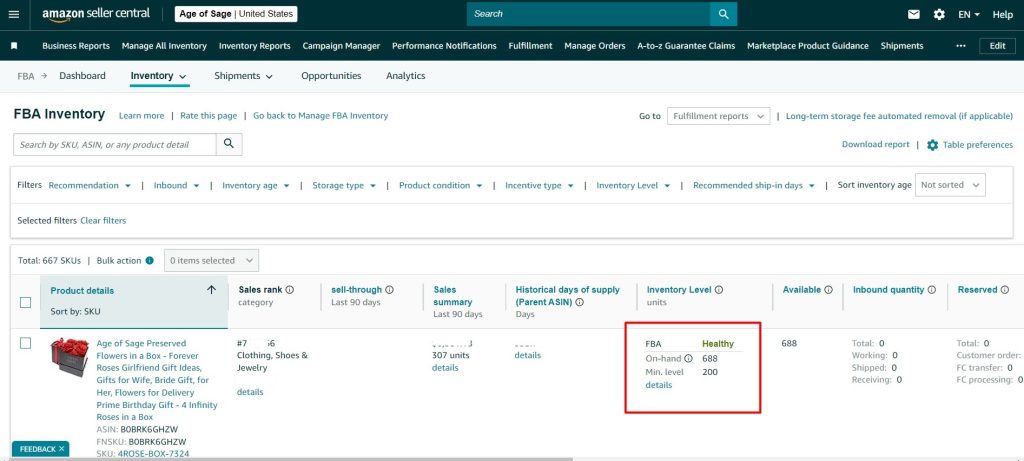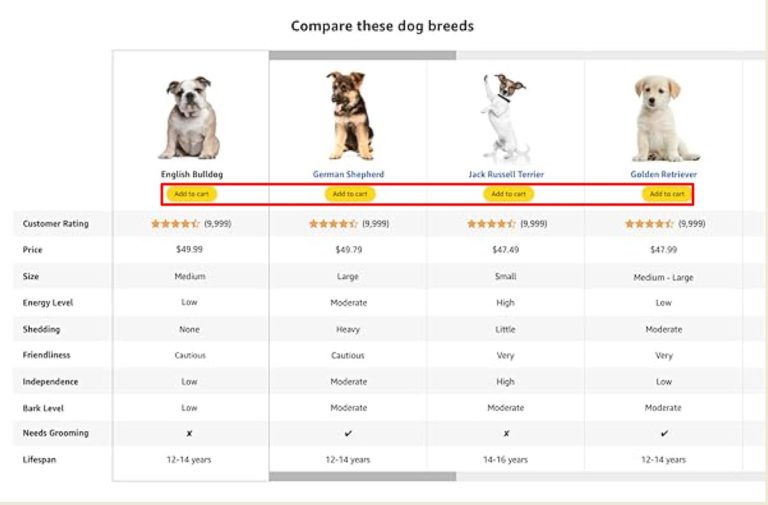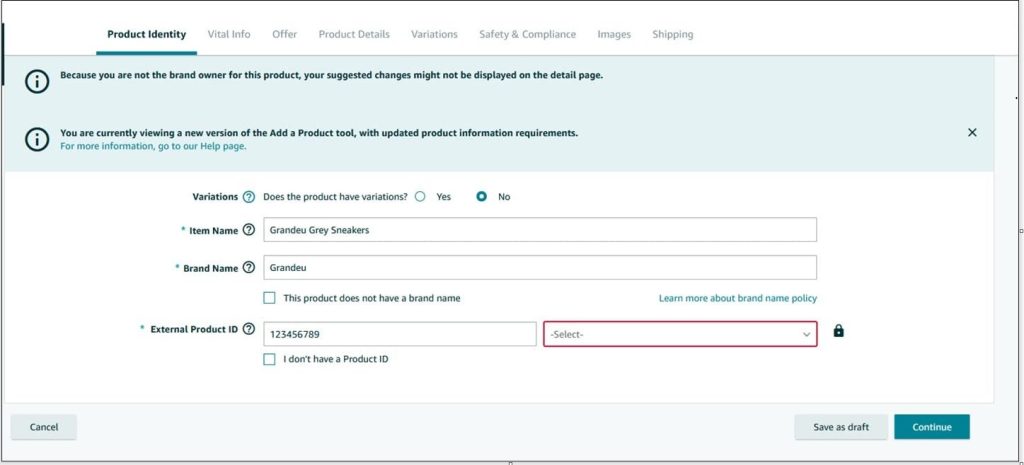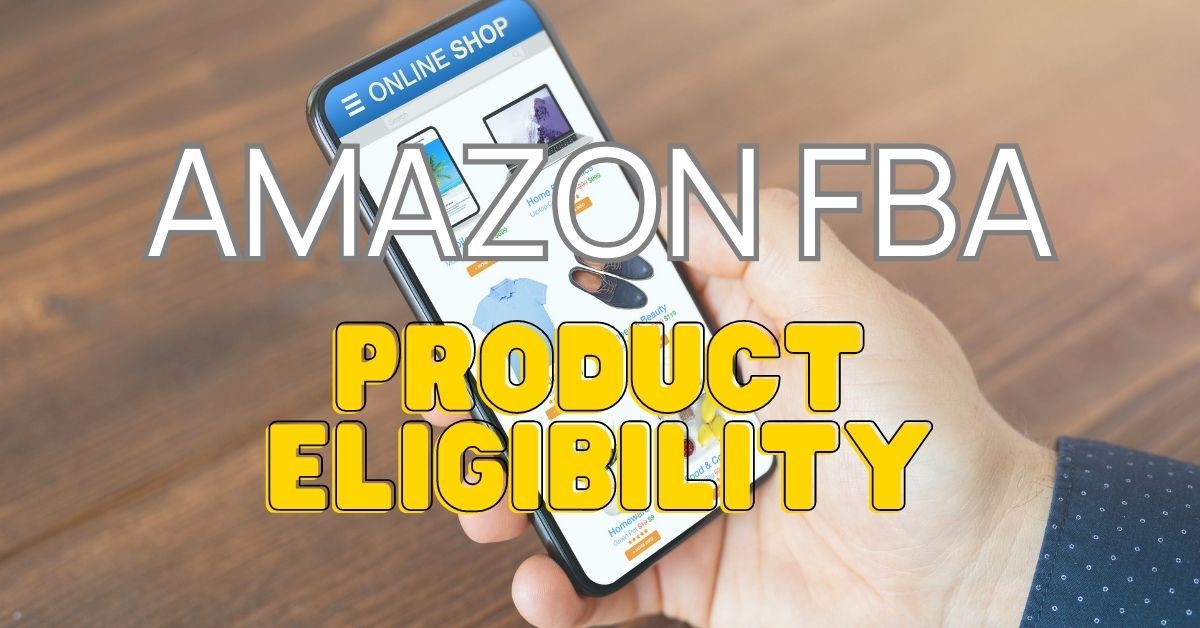Several Amazon Seller Central updates were released in 2023 and it’s crucial that you are aware about these changes. This awareness will empower you to turn challenges into opportunities.
Change is inevitable, especially in the fast-paced world of Amazon. New features, policy tweaks, and algorithm adjustments land in your Seller Central dashboard like clockwork. Some updates bring exciting opportunities, while others feel like unwelcome guests at a family dinner.
But whether you’re cheering or groaning, understanding and adapting to these changes is crucial for surviving, let alone thriving, on the Amazon battlefield.
1. Amazon Seller Central Updates: New Minimum Inventory Level Metric

The introduction of the Minimum Inventory Level metric on Amazon Seller Central brings a significant impact on sellers, offering a valuable tool to enhance inventory management. Here’s how sellers can leverage this update to benefit their business:
Effective Inventory Planning:
- The Minimum Inventory Level metric is designed to assist FBA sellers in planning inventory levels more effectively.
- Utilize the advanced machine learning models provided by Amazon to analyze demand forecasts and replenishment settings.
Avoiding Low-Inventory-Level Fee:
- The metric helps sellers avoid the recently announced low-inventory-level fee by recommending the minimum number of units per product to keep in fulfillment centers.
- Maintaining inventory above this minimum level is crucial for preventing additional fees and ensuring smooth operations.
Faster Delivery Speeds and Increased Sales:
- Keeping inventory above the Minimum Inventory Level allows for faster delivery speeds, as products can be distributed across local fulfillment centers closer to customers.
- Sellers who maintain units above this level have experienced a 15% increase in sales over a four-week period on average, though results may vary.
Accessing the Metric:
- To view your Minimum Inventory Level metric, navigate to FBA Inventory on Seller Central.
Integration with Other Tools and Metrics:
- The Minimum Inventory Level metric works in conjunction with other important tools and metrics, such as Historical days of supply, Inventory Performance Index (IPI), Capacity limits, and Restock recommendations.
Historical Days of Supply:
- Effective April 1, 2024, the low-inventory-level fee applies when both long-term and short-term historical days of supply are below 28 days (4 weeks). Check your historical days of supply on the FBA Inventory page.
Inventory Performance Index (IPI):
- Maintaining the Minimum Inventory Level positively contributes to your IPI score, reflecting efficient inventory management.
- The Inventory Performance dashboard will be updated to reflect this change in the coming weeks.
Capacity Limits:
- Your capacity limits are influenced by your IPI score and other factors, ensuring you have enough inventory to avoid the low-inventory-level fee.
Restock Recommendations:
- Restock recommendations will continue to provide specific ship-by dates and replenishment quantities. Look forward to their integration into the FBA Inventory page for added convenience in the coming weeks.
Possible Challenges
Fluctuating Sales Patterns:
- Rapid changes in consumer behavior or market trends may lead to unexpected fluctuations in sales patterns, potentially impacting the accuracy of demand forecasts.
- Mitigation: Stay agile in adjusting inventory levels based on real-time market changes and leverage additional data sources for more comprehensive insights.
Costs of Maintaining Higher Inventory:
- While maintaining inventory above the minimum level can lead to faster delivery speeds and increased sales, it also involves higher holding costs for sellers.
- Mitigation: Conduct a cost-benefit analysis to ensure that the benefits of faster delivery and increased sales outweigh the additional costs associated with higher inventory levels.
Integration Complexity:
- Coordinating the Minimum Inventory Level metric with other tools and metrics, such as IPI, Historical Days of Supply, and Capacity Limits, may pose integration challenges for some sellers.
- Mitigation: Invest time in understanding the interconnections between metrics and tools, and seek guidance from Amazon’s educational resources.
2. Amazon Seller Central Updates: Partnered Carrier Program Shipping Services
The recent updates on Amazon Seller Central related to using partnered carriers bring several improvements for sellers, enhancing efficiency and providing more control over the shipping process. Here’s how sellers can navigate these changes to grow their business:
Warehouse Hours and Special Instructions:
- Sellers can now input their warehouse operating hours and specify special pickup equipment requirements when entering the ship-from address.
- Action Point: Ensure accurate and up-to-date information about your warehouse’s operating hours and any special pickup equipment needs to streamline the shipping process.
Enhanced Pickup Dates:
- The update allows sellers to access the latest shipment pickup date information for less-than-truckload, full-truckload, and intermodal shipments.
- Pickup date information now includes updates in case of disruptions or delays, providing better visibility into the shipping timeline.
- Action Point: Regularly check and utilize the enhanced pickup date information to optimize shipment planning and logistics.
Shipment Updates for Delays:
- In case of delays or disruptions affecting shipment pickup, sellers will receive updated pickup date information in the Shipping Queue and on the shipment’s summary page.
- This feature helps sellers adapt to unforeseen circumstances and make necessary adjustments to their shipping plans.
- Action Point: Stay informed about any shipment updates due to delays and take proactive measures to manage inventory and customer expectations accordingly.
New Partnered Carrier Guide:
- Amazon has introduced a new PDF guide (English only) that offers detailed information and expectations when creating and sending a shipment with an Amazon partnered carrier.
- The guide provides valuable insights into the process, ensuring a smoother experience for sellers utilizing partnered carriers.
- Action Point: Familiarize yourself with the new partnered carrier guide to optimize your shipping processes and address any specific requirements.
Possible Challenges
Accuracy of Warehouse Information:
- Accuracy and timeliness in providing warehouse operating hours and special pickup equipment requirements are crucial. Incorrect or outdated information may lead to inefficiencies in the shipping process.
- Mitigation: Regularly review and update warehouse details to ensure accuracy in Amazon’s system.
Dependency on Partnered Carrier System:
- Sellers relying on partnered carriers may face challenges if there are disruptions or technical issues within the carrier’s system that affect the accurate transmission of pickup date information.
- Mitigation: Establish contingency plans and communication channels with carriers to address unexpected system issues promptly.
Unforeseen Delays and Disruptions:
- Despite the provision of enhanced pickup date information and updates for delays, sellers may still encounter unforeseen disruptions that impact shipping timelines.
- Mitigation: Maintain a flexible approach to shipment planning, build in buffer times, and communicate proactively with customers about potential delays.
Learning Curve for New Processes:
- Sellers may experience a learning curve in adapting to the new processes outlined in the partnered carrier guide, potentially leading to errors in shipment creation and fulfillment.
- Mitigation: Invest time in thoroughly understanding the new guide, provide training to relevant team members, and seek clarification on any ambiguous points.
Language Limitations in Partnered Carrier Guide:
- The availability of the partnered carrier guide in English only may pose challenges for sellers who are not proficient in English, potentially leading to misunderstandings or misinterpretations of crucial information.
- Mitigation: Utilize translation tools or seek assistance from multilingual team members to ensure accurate comprehension of the guide.
Communication Challenges with Partnered Carriers:
- Effective communication with partnered carriers regarding specific requirements, delays, or disruptions may pose challenges, especially if there are language barriers or if carriers are unresponsive.
- Mitigation: Establish clear communication channels, provide written instructions, and have alternative contact methods for urgent situations.
3. Amazon Seller Central Updates: New Shoppable Premium A+ Content Module

Here’s how sellers can leverage this New Shoppable Premium A+ Content Module to grow their business:
Double Brand-Cart Conversion Rates:
- The shoppable A+ Content module is designed to enhance brand-cart conversion rates by allowing customers to add items to their cart directly from the module.
- Real-time prices for in-stock and buyable items, along with customer review rating summaries, provide customers with the information they need to make quick and informed purchase decisions.
Streamlined Purchase Decision Process:
- The new module enables customers to compare different products on a single page, streamlining the purchase decision process.
- By presenting product information and pricing in a visually appealing and easily accessible format, sellers can improve the overall customer experience.
Boosting New Product Sales:
- The shoppable A+ Content module displays new products alongside existing ones, providing an opportunity to boost sales for newly introduced items.
- Sellers can leverage this feature to showcase and promote new products effectively, potentially increasing the visibility and sales of these items.
Higher Cart Conversion Rates:
- The shoppable Premium A+ Comparison Chart module has demonstrated a 2x higher cart conversion rate compared to existing Premium Comparison Chart modules that aren’t shoppable.
- Sellers can benefit from increased conversion rates, leading to more items being added to customers’ carts directly from the shoppable module.
Improved Comparison Chart Builder:
- The enhanced comparison chart builder offers customization options, allowing sellers to control the order of products displayed in the module.
- Automatic population of product information for listed products streamlines the content creation process, saving time for sellers.
Action Points for Sellers
- Optimize A+ Content: Ensure that your A+ Content is well-optimized with compelling visuals, accurate product information, and persuasive content to make the most of the shoppable module.
- Highlight New Products: Take advantage of the module to showcase and highlight new products, leveraging the potential for increased sales.
- Monitor Performance: Regularly monitor the performance metrics associated with the shoppable A+ Content module, such as cart conversion rates, to gauge its effectiveness.
- Utilize Comparison Chart Builder: Use the improved comparison chart builder to customize the order of products and streamline the creation of content for better visual appeal.
Potential Drawbacks
While the introduction of the shoppable A+ Content module with double brand-cart conversion rates on Amazon Seller Central provides significant benefits, sellers should be aware of potential challenges or drawbacks:
User Experience Consistency:
- Depending on the content and design implementation, the shoppable A+ Content module might provide a different user experience compared to other parts of the seller’s storefront. Consistency in user experience across the platform is crucial for brand trust and customer satisfaction.
Overemphasis on Price:
- Real-time prices displayed in the module may lead customers to focus excessively on pricing, potentially overshadowing other important product features. Sellers may face challenges if their products are perceived as solely competing on price rather than value.
Customer Decision Overload:
- While the module aims to streamline the purchase decision process, presenting too much information in a single page could overwhelm customers, leading to decision fatigue. Sellers should carefully balance information presentation to avoid customer overload.
Impact on Non-Shoppable Modules:
- The emphasis on the shoppable A+ Content module’s effectiveness may inadvertently lead to reduced engagement with non-shoppable Premium Comparison Chart modules. Sellers should monitor the performance of non-shoppable modules to ensure a holistic approach to content optimization.
Visibility for New Products:
- While the module provides an opportunity to boost sales for new products, there is a risk that existing popular products may overshadow new additions. Sellers should strategically manage the placement of new products within the module to ensure visibility and customer attention.
Potential for Misleading Visuals:
- Sellers should be cautious in creating visually appealing content, ensuring that it accurately represents the product features and benefits. Overemphasis on aesthetics without conveying accurate information might lead to customer dissatisfaction or returns.
Dependency on A+ Content Quality:
- The effectiveness of the shoppable A+ Content module is contingent on the quality of the content created. Poorly designed or misleading content may not only result in a lack of conversion but could potentially harm the brand’s reputation.
Adjustment Period for Sellers:
- Sellers may face a learning curve in adapting to the new comparison chart builder and utilizing the customization options effectively. It might take time for sellers to optimize their content creation process and fully leverage the benefits offered by the enhanced builder.
4. Amazon Seller Central Updates: Brand Story A/B Tests
The introduction of A/B testing for Brand Story content on Amazon Seller Central offers registered brands a valuable opportunity to enhance their brand visibility, drive sales, and increase repeat purchases. Here’s how sellers can leverage this update to grow their business:
Optimizing Brand Story Content:
- A/B testing allows sellers to experiment with different variations of Brand Story content to identify what resonates best with their audience.
- Use this feature to optimize storytelling elements, carousel displays, image and text cards, and product links to create a compelling brand narrative that attracts and engages customers.
Generating More Sales:
- A/B testing enables sellers to refine their Brand Story content for maximum impact on sales.
- Identify high-performing elements that drive conversions and strategically use them to highlight key products, promotions, or unique selling points that encourage customers to make purchases.
Increasing Repeat Purchases:
- Tailor Brand Story content to not only attract new customers but also to engage existing ones.
- Experiment with content variations that encourage repeat purchases, such as showcasing complementary products, exclusive offers, or loyalty programs.
Peak Sale Events and Holidays:
- Capitalize on peak sale events and holiday seasons by strategically using A/B tested Brand Story content.
- Customize the content to align with specific promotions, seasonal themes, and shopping trends to maximize its impact during periods of heightened customer activity.
Cross-Selling Opportunities:
- Leverage Brand Story content to create cross-selling opportunities by featuring related or complementary products within the carousel displays.
- Encourage customers to explore additional offerings from your brand, increasing the average order value and overall sales.
Driving Traffic to Brand Store:
- Use A/B tested Brand Story content to drive traffic to your brand store, providing customers with a comprehensive view of your product catalog.
- Ensure that the content is designed to guide customers seamlessly from the Brand Story to the brand store for a cohesive shopping experience.
Showcasing New Product Launches:
- Highlight new product launches within the Brand Story content to generate excitement and interest.
- A/B testing can help refine the presentation of new products, ensuring that they capture attention and drive successful launches.
Bulk Upload Feature:
- Take advantage of the bulk upload feature to efficiently implement Brand Story content across your catalog.
- Streamline the process of updating and optimizing content for a large number of products, ensuring consistency in brand messaging and storytelling.
Challenges to Expect
Resource Intensiveness:
- Conducting A/B tests and optimizing Brand Story content can be resource-intensive, requiring time and effort to analyze results and make informed decisions.
- Mitigation: Allocate sufficient resources and plan testing schedules to ensure a balance between optimization efforts and other business activities.
Complexity in Analysis:
- Interpreting A/B test results and understanding which variations resonate best with the audience can be complex.
- Mitigation: Invest in analytics tools or seek professional assistance to accurately interpret and act upon the data generated by A/B tests.
Inconsistent Brand Messaging:
- Frequent A/B testing may lead to inconsistencies in brand messaging if not managed carefully, potentially confusing customers.
- Mitigation: Establish clear brand guidelines and ensure that any variations tested align with the overall brand narrative and identity.
Potential for Customer Disengagement:
- Continuous testing of Brand Story content may lead to customer fatigue or disengagement if variations are too frequent or disruptive.
- Mitigation: Implement A/B tests thoughtfully and monitor customer feedback to gauge their receptiveness to content changes.
Overemphasis on Sales Events:
- While A/B testing during peak sale events and holidays can be beneficial, there’s a risk of overemphasizing these periods and neglecting content optimization during regular business days.
- Mitigation: Maintain a balanced approach to A/B testing, considering both peak and non-peak periods.
Cross-Selling Effectiveness:
- The effectiveness of cross-selling opportunities within carousel displays may vary based on the relevance and appeal of featured complementary products.
- Mitigation: Monitor customer responses and adjust cross-selling strategies based on performance data and customer feedback.
Potential for Brand Store Overlook:
- While driving traffic to the brand store is a goal, there’s a risk that customers may overlook the Brand Story content and navigate directly to product listings.
- Mitigation: Design the Brand Story content to be compelling and guide customers seamlessly toward exploring the brand store.
Limited Impact on New Product Launches:
- A/B testing may not guarantee immediate success in showcasing new product launches within the Brand Story content.
- Mitigation: Implement additional marketing strategies and promotions to complement the Brand Story content and maximize the impact of new product launches.
Bulk Upload Challenges:
- While the bulk upload feature is convenient, managing a large catalog with frequent updates may pose challenges in maintaining consistency and quality across all Brand Story content variations.
- Mitigation: Develop a robust system for content management, regularly review bulk uploads, and conduct quality checks to ensure accuracy.
Watch this video to learn more:
5. Amazon Seller Central Updates: Detail Page Videos in Multiple Languages
You can leverage this update to grow your business by:
Increased Sales:
- By providing videos in secondary languages, sellers can reach a broader audience and cater to customers who may prefer information in languages other than the primary one.
- Consider creating videos that showcase the features, benefits, and usage of your products, allowing customers to make more informed purchasing decisions.
Global Reach and Accessibility:
- Uploading videos in secondary languages enables sellers to connect with customers around the world, tapping into diverse markets.
- Catering to a global audience can open up new opportunities for sales and expansion into international markets.
Improved Customer Experience:
- Videos serve as valuable educational tools, helping customers understand product usage, setup, and troubleshooting in their preferred language.
- Enhance the customer experience by providing clear and concise instructional videos that address common queries or concerns.
Reduced Returns:
- Well-informed customers are less likely to experience issues with product setup or usage, reducing the likelihood of returns due to misunderstandings.
- Use videos to preemptively address common questions or concerns, empowering customers to use the product correctly.
Optimized Product Detail Pages:
- Embed videos strategically on product detail pages to complement written content. This can make your listings more engaging and informative.
- A well-optimized product detail page, including videos in multiple languages, can positively impact conversion rates.
Educational Content:
- Leverage videos not only for promotional purposes but also for educational content. This can include tutorials, demonstrations, and troubleshooting guides in different languages.
- Educational content can position your brand as a helpful resource, fostering customer loyalty and positive reviews.
Proactive Customer Support:
- Anticipate customer needs by addressing common queries through instructional videos. This proactive approach can reduce the volume of customer support inquiries and enhance customer satisfaction.
- Include links to these videos in customer communications to provide additional support resources.
Here is a related videos you can watch:
Possible Drawbacks
While leveraging videos in secondary languages on Amazon Seller Central can bring about various benefits, sellers should be aware of potential challenges and drawbacks associated with this approach:
Production Costs:
- Creating videos in multiple languages can increase production costs, including translation, voiceover, and video editing expenses.
- Mitigation: Carefully assess the return on investment and prioritize languages based on target markets to manage production costs effectively.
Consistency in Messaging:
- Maintaining consistency in messaging across videos in different languages can be challenging. Variations in interpretation may lead to discrepancies in how product features and benefits are communicated.
- Mitigation: Develop comprehensive brand guidelines and collaborate closely with translators to ensure accurate and consistent messaging.
Cultural Sensitivity:
- Videos may inadvertently include content that is culturally insensitive or misunderstood in certain regions.
- Mitigation: Conduct thorough cultural research or consult with local experts to ensure that videos are culturally appropriate and do not unintentionally offend or mislead customers.
Platform Compatibility:
- Some customers may face compatibility issues with certain video formats or platforms, impacting their ability to access and view the content.
- Mitigation: Optimize videos for various devices and platforms, ensuring a seamless viewing experience for a diverse audience.
Translation Quality:
- The quality of translations in videos is crucial for effective communication. Poor translations may lead to misunderstandings and negatively impact the customer experience.
- Mitigation: Invest in professional translation services to ensure accurate and culturally relevant translations that resonate with the target audience.
Global Legal and Regulatory Compliance:
- Different regions may have varying legal and regulatory requirements related to product information and advertising. Ensuring compliance across multiple languages and regions can be complex.
- Mitigation: Conduct a thorough review of legal and regulatory requirements in each target market and adapt video content accordingly.
Resource Intensiveness for Customer Support:
- While videos can help reduce customer support inquiries, addressing a diverse customer base in multiple languages may still require additional resources for customer support teams.
- Mitigation: Implement robust customer support strategies and consider multilingual support options to efficiently address inquiries.
Technical Challenges:
- Technical challenges such as slow internet speeds or limited access to video content in certain regions may impact the effectiveness of using videos as educational tools.
- Mitigation: Offer alternative formats, such as written guides or FAQs, to accommodate customers facing technical limitations.
Action Points for Sellers
- Strategic Language Selection: Prioritize languages based on market potential and customer demographics to manage production costs effectively.
- Continuous Quality Assurance: Implement processes for continuous quality assurance of video content, including translations and cultural sensitivity checks.
- Comprehensive Cultural Research: Conduct thorough research on cultural nuances to avoid unintended misunderstandings or misinterpretations in video content.
- Legal Compliance Review: Regularly review and update video content to ensure compliance with legal and regulatory requirements in each target market.
6. Amazon Seller Central Updates: Changes To Listing Requirements

These changes to the listing requirements provide opportunities to sellers, such as
Optimized Listings:
- Use this update as an opportunity to review and optimize your product listings. Ensure that all relevant information is accurately represented, contributing to a positive customer experience.
Enhanced Data Quality:
- Embrace the changes to improve the overall quality of your product data. Accurate and comprehensive product information can lead to increased customer trust and satisfaction.
Proactive Communication:
- Stay informed about updates and communicate proactively with Amazon. Participate in feedback mechanisms and ensure that your concerns or suggestions are conveyed to the platform.
Efficiency in Listing Process:
- Familiarize yourself with the new grouping tabs and templates to streamline the listing process. Efficiency in creating and editing listings can save time and resources.
Potential Issues To Anticipate
Changes to “Add Products” Page
Learning Curve:
- Sellers accustomed to the previous layout may face a learning curve with the updated grouping tabs such as Product Details, Safety & Compliance, and Shipping.
- Challenge: Sellers may need time to adapt to the new structure, potentially leading to delays in the listing process.
Relevance of Attributes:
- If new required attributes are introduced, sellers may find some attributes that aren’t relevant to their products.
- Challenge: Identifying and managing irrelevant attributes can be time-consuming. Sellers must proactively provide feedback, but the resolution process may not be immediate.
Changes to “Add Products via Upload”
Transition Period:
- Sellers using “Add Products via Upload” will need to adapt to the new listing templates with updated attribute requirements.
- Challenge: During the transition period, managing both old and new templates may pose operational challenges, and sellers must ensure consistency in their listings.
Compatibility Issues:
- Sellers might face compatibility issues when transitioning to new templates, especially if their existing systems or processes are not immediately compatible.
- Challenge: Ensuring a smooth transition without disruptions to existing workflows can be challenging, particularly for sellers with established systems.
Template Updates:
- Sellers are encouraged to upgrade to new templates, but some may resist change or delay the transition.
- Challenge: Resistance to template updates could result in delayed adoption of improved attribute requirements, potentially affecting listing quality.
Notice Period:
- The notice period of at least 30 days before the new template becomes the default option may lead to procrastination among sellers.
- Challenge: Sellers might postpone adapting to the new templates until the last minute, leading to potential bottlenecks and hurried adjustments.
Here is a related video you can watch:
General Challenges
Customer Support Issues:
- Sellers may encounter challenges related to customer support if there are delays or difficulties in adapting to the changes.
- Challenge: An increase in customer queries or issues related to product listings can strain customer support resources.
Temporary Disruptions:
- During the transition period, there might be temporary disruptions in the listing process as sellers adjust to the changes.
- Challenge: Temporary disruptions could impact the efficiency of sellers, potentially affecting productivity and timely listing updates.
Communication Gaps:
- Sellers may face challenges if there are communication gaps between Amazon and individual sellers regarding the changes and their implications.
- Challenge: Inadequate communication could lead to misunderstandings and delays in implementing the necessary adjustments.
Technical Challenges:
- Sellers with limited technical capabilities may find it challenging to navigate and utilize the updated features efficiently.
- Challenge: Technical challenges could hinder sellers’ ability to optimize their listings, potentially impacting the visibility of their products.
Mitigation Strategies
- Proactive Training: Offer training resources to sellers to help them quickly adapt to the new listing process.
- Clear Communication: Facilitate clear communication between Amazon and sellers to minimize misunderstandings and ensure a smooth transition.
- Guidance for Irrelevant Attributes: Provide sellers with clear guidance on how to handle irrelevant attributes to streamline the feedback process.
Conclusion
Amazon is a constantly evolving marketplace. To survive and thrive, sellers must learn how to navigate through the constantly released Amazon Seller Central updates.
By embracing a proactive approach to understanding and navigating these updates, sellers can position themselves for sustained success in the ever-evolving landscape of e-commerce.









